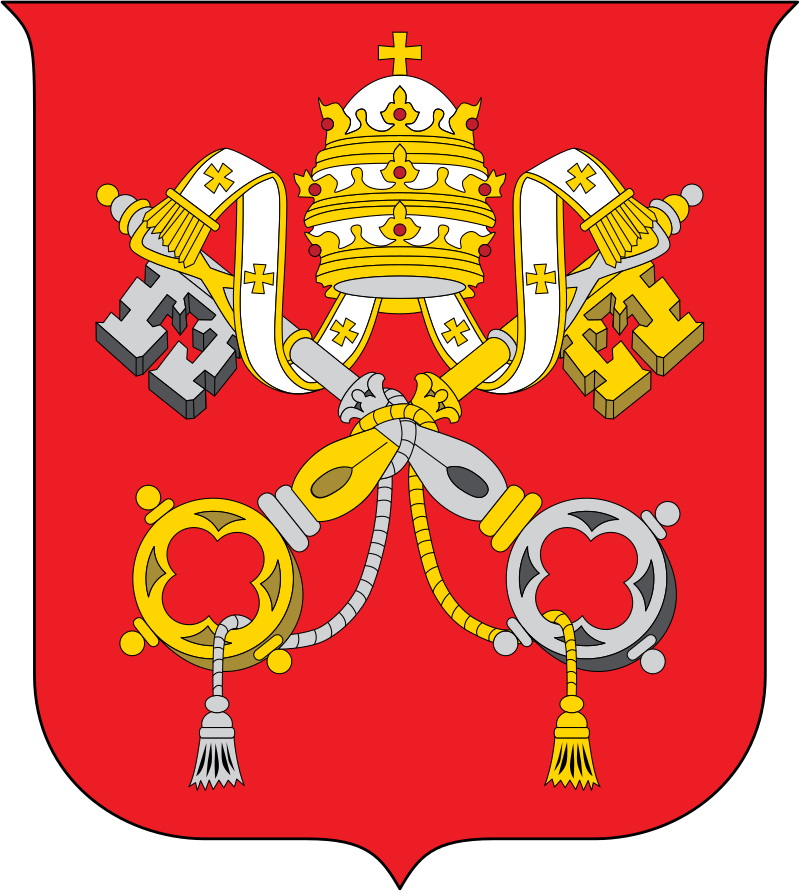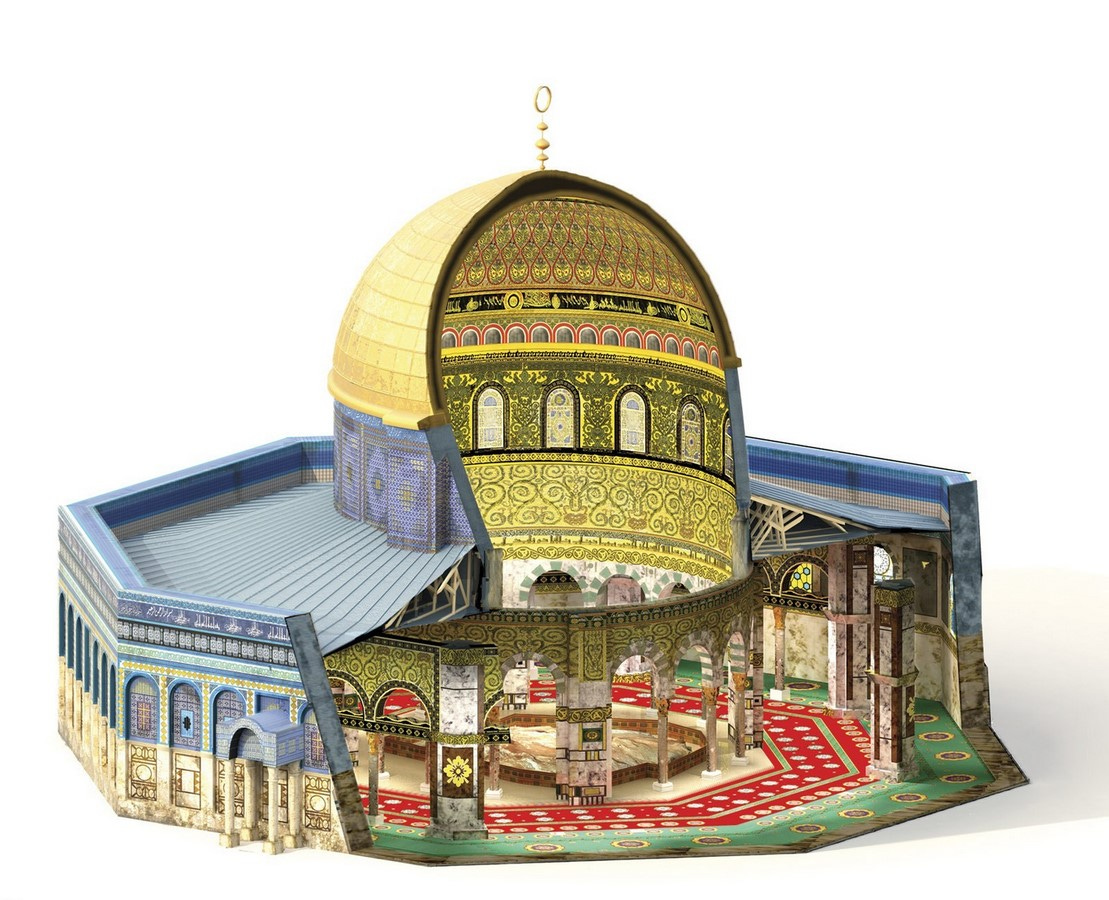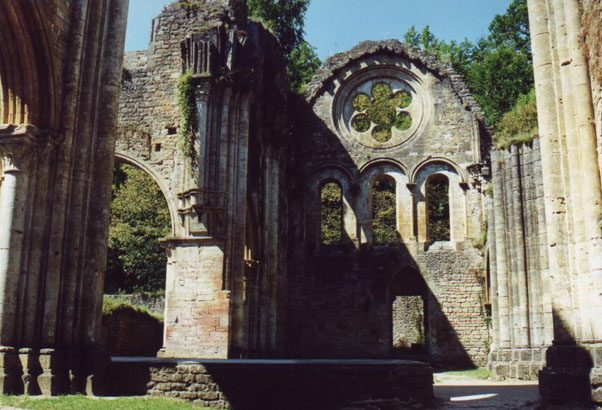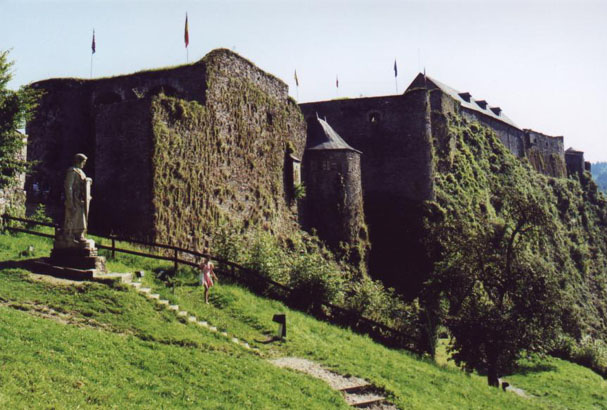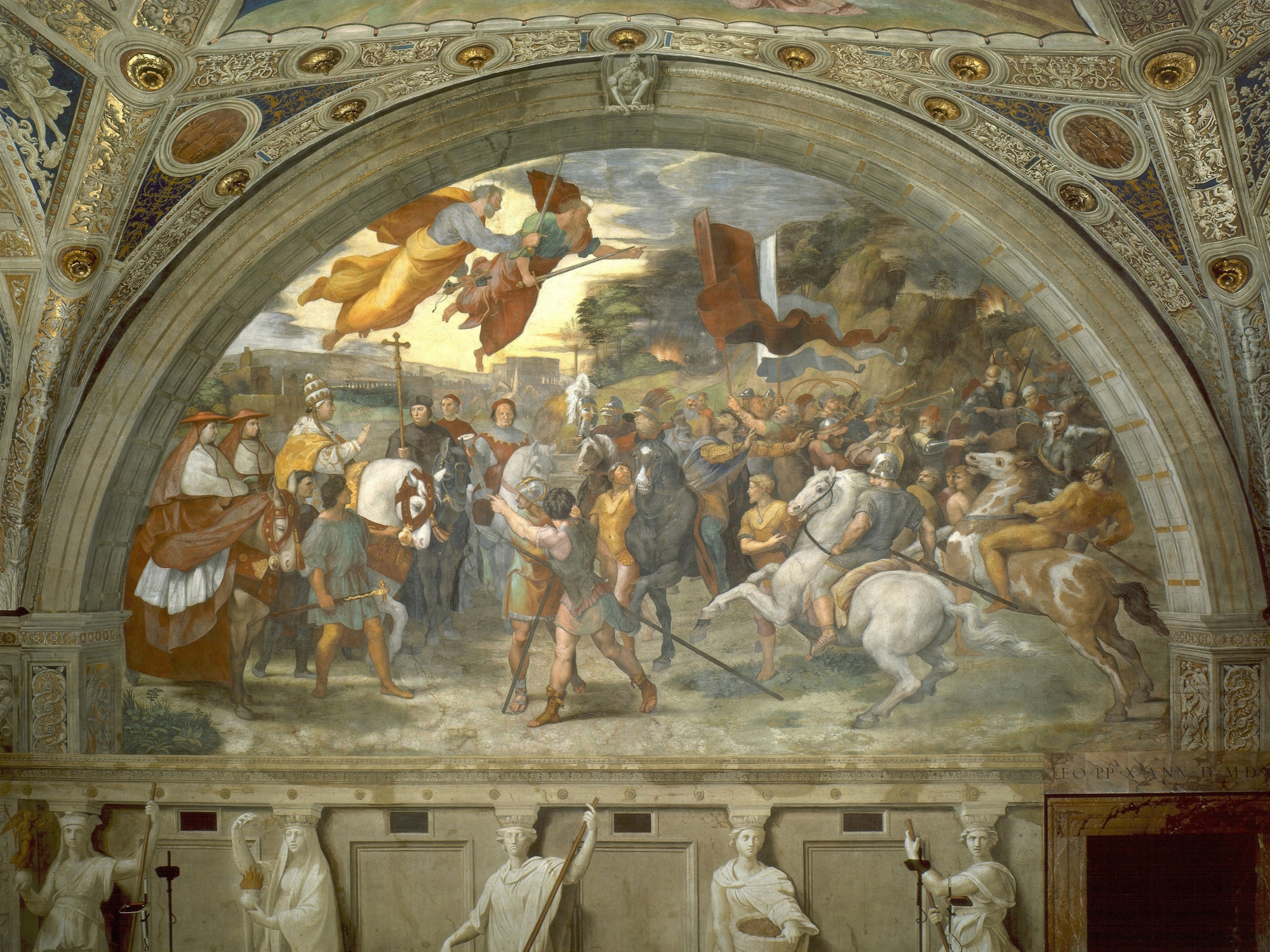
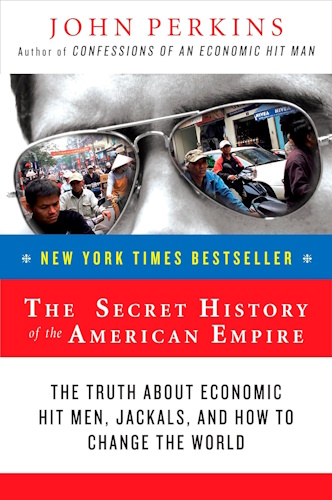

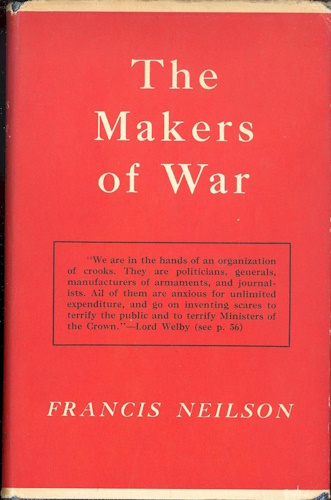

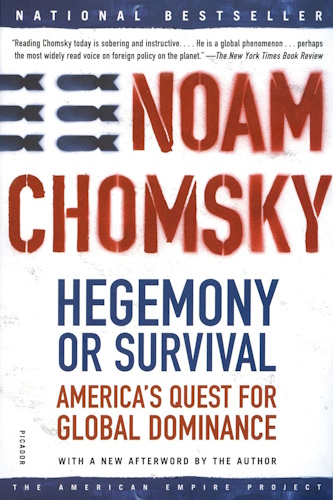



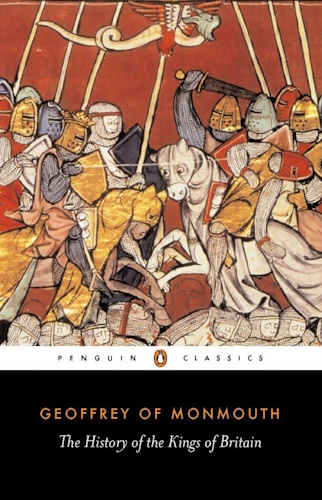

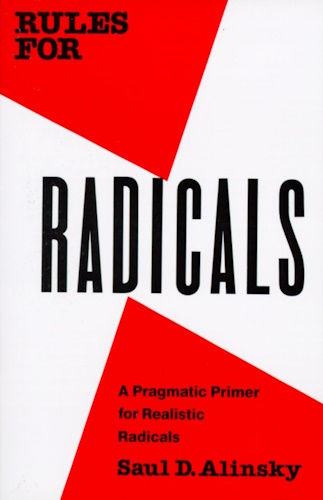

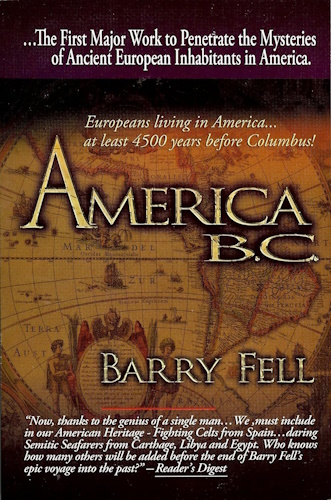

Whence & Pence
A Series
by
Douglas V. Gnazzo
January 6, 2005 - April 18, 2005
(Retrieved from archive.org)
![]()
Part 3: The Sounding
January 25, 2005
And on the upper step, God's angel – seated
upon the threshold, which appeared to me
to be of adament – kept his feet planted.
And from beneath that robe he drew two keys; the one
was made of gold, the other was of silver;
first with the white, then with the yellow key,
he plied the gate so as to satisfy me.
"Whenever one of these keys fails, not turning
appropriately in the lock," he said
to us, "this gate of entry does not open.
One is more precious, but the other needs
much art and skill before it will unlock –
that is the key that must undo the knot."
[Dante]
INTRODUCTION
Whence & Pence, Part Two: The Confounding left off with a brief introduction of King Philip of France, Pope Clement V, and The Knights Templar. We will now attempt to shed some light on the role in history these three played, as only such a unique triumvirate could call forth the destiny that resulted in the heinous acts of Friday, October the 13th, 1307: The legacy of doom referred to as the Inquisition; and from whence it came – Cui Bono?
THE FIRST CRUSADE
At the Synod of Clermont in 1095, Pope Urban II sounded a call to arms for help from Western Europe to take Jerusalem back from the Muslims. A most interesting group responded, a twice times three triumvirate of sorts, but this one included groups, not individuals. The First Crusade was actually made up of six different armies that were comprised as follows:
Peter The Hermit led an army of lower knights and peasants – The People's Crusade
The Noble Barons that were of five groups as follows:
The papal legate Adhemar of Le Pue and Raymond IV of Toulouse leading the Knights of Provence
The Normans led by Bohemund I of Antioch, Count of Taranto; Roger I who was the ruler of Sicily; Tancred, Prince of Galilee and nephew of Bohemund and grandson of Robert Guiscard
Knights of Lorraine, including Godfroi de Bouillon; his two brothers, Eustace and Baldwin of Boulogne
The Flemings from Belgium, led by Robert II of Flanders
Knights of Northern France led by Robert Duke of Normandy who was the older brother of King William II of England, their father being William the Conqueror, who left us the literary masterpiece the Domesday Book; Stephen II Count of Blois and Count of Chartres; Hugh of Vermandois called "the Great" who was the younger brother of King Philip I of France.
Poor King Philip couldn't make the Crusade, as the Pope had excommunicated him. It was an act of noblisse that his younger brother took his place. Quite a group to say the least, and the most intriguing part is that they were all more or less related, either by blood or by marriage, or both.
In keeping Royal lines of descent, a good marriage broker was more important than an investment broker, although it was kind of the same thing; maybe 'tis true that the easiest way to acquire wealth is to inherit it, as it seems to have worked quite well for Royalty. It takes a bit of time, but the inter-relationships between the Royal Houses of Europe are fascinating, almost unbelievable. The above links provide more links that eventually tell the tale fairly well.
When the Pope sounded a call to arms he didn't think that a hundred thousand individuals would respond. Peter the Hermit was the first to head for Jerusalem, months before the army of Knights and Nobles sanctioned by Pope Urban II had left. The People's Crusade (Hermit and followers) ended very badly, almost all were killed.
Months after the People's Crusade had embarked for Jerusalem, the Knights and Nobles the Pope had consecrated with his blessing parted for the Holy Land. This was a large contingency, but not the fortuitous kind. It was comprised of five separate armies as described above. The year was 1096. The armies went by way of different routes, but all regrouped at Constantinople. The journey and final siege of Jerusalem took almost three years to complete.
It has been recorded that the 70,000 inhabitants of Jerusalem were massacred, either during the siege of the city, or upon the final defeat and capture of the citadel by the Crusaders, who recall, represented the Holy Roman Catholic Church. A bit confounding that the Pope, the supposed Vicar of Christ on Earth, would sanction the massacre of so many people. Maybe he figured by killing them it would hasten the redemption of their souls. Whatever his justification, it does seem a bit at odds with the teachings of Chirst. Perhaps it was thought that the Muslims would just peacefully surrender. But enough of this.
Godfroi de Bouillon was made Advocatus Sancti Sepulchri or Protector of the Church of the Holy Sepulchre, where Christ's body was supposedly entombed. Godfrey, as he was also called, died the following year, and his brother Baldwin succeeded him. Baldwin, however, was crowned the first King of Jerusalem; as Godfrey had founded the Kingdom of Jerusalem which was declared a country. In Whence & Pence, Part Two: The Confounding it was shown that Kings were sovereigns that held suzerainty over the kingdom they ruled, so Baldwin figured – what the heck, might as well go with the flow, not that it was a fortuitious flow; but it was the reason why he went there.
JERUSALEM
Jerusalem is a very important little piece of real estate, for many different reasons, some of which we will endeavor to decipher as we proceed. Besides being home to the Church of the Holy Sepulchre, it was also home to King Solomon's Temple, and the Al-Aqsa Mosque. Upon the capture of Jerusalem, Tancred "claimed" control of the Temple Quarter. By what authority he made this claim has never quite been explained; another confounding, as Baldwin was the King – at least he was crowned the King, but alas, one never knows for sure who pulls the strings, or owns them.
"Nor fire nor brazen wall can keep out fate"
[Pindar]
Originally, Jerusalem was settled by the Jebusites, a tribe of Canaanites, who inhabited the region around 1500-1000 BC. In 1004 BC, King David conquered the Jebusites, and took possession of Jerusalem. David made Jerusalem the capital of the Kingdom of Israel. What makes Jerusalem so desirable, at least in the minds and souls of those that desire it, is that it is the home to what is called the Temple Mount or Noble Sanctuary. But as Mick says, "."
David wanted to build a new temple, but died before he could undertake the work. His son, Solomon, built the first temple known as Solomon's Temple. During Solomon's rule, Jerusalem rose to great heights, in commerce, architecture, and overall well-being. Solomon had a penchant for wealth. He is said to have collected 666 talents of gold as tribute from conquered nations according to 1 Kings 10:13. At first, Solomon was considered a wise and good leader, but in later years his wealth made him decadent, and he began worshipping idols and pagan gods. He had over 300 concubines. He is reputed to have had some interesting helpers in building the Temple.
Jerusalem includes the sacred ground upon which the First and Second Temples were built, as well as the third to come during the time of the final coming of the Messiah; the Islamic Dome of the Rock; and the Al-Aqsa Mosque; and Christianity claims it to be the spot of Abraham's trials and Jacob's visions, and it is home to the Church of the Holy Sepulchre. Hence the Temple Mount is deemed Sacred Ground to all three of the worlds monotheistic religions, and it has been a hot spot of contention from day one to the present day's unresolved conflict. It may be the most coveted piece of real estate on Earth. Probably coincidental that the three monotheistic religions are descended from the same blood lines. Sure are lots of coincidences.
TANGENTIAL DELUSIONS
There were plenty of battles and Crusades, enough to fill volumes, but such is beyond the scope and purpose of this work. However, a quick synopsis of a part of the First Crusade not readily told is in order, as it is not only an important piece of history when it occurred, but it has had major ramifications all through history; and it will be revisited later to help connect some dots.
Anti-Semitism has existed since before the time of Christ, all through history, up to the present day. It is one of the important issues that the human race must deal with, overcome, and learn and grow by. Such sentiment was prevalent in Europe before the First Crusade, however, the Crusade was the first manifestation of an organized societal uprising against the Jews that involved large scale violence, including mass killings, at least since ancient times.
In 1096, approximately 10,000 German soldiers set off on their own little Crusade. They were led by Emich of Leiningen, Volkmar, and Gottschalk. They marched into the Rhine Valley which was in the complete opposite direction from Jerusalem. Seems they had had an epiphany that revealed to them that exterminating the Jews was the same as exterminating the Muslims.
When one starts talking and acting out extermination, such 180 degree directional mistakes can easily be made; or perhaps they aren't so much mistakes as atrocities committed under false pretense and rationalizations according to the guise of a supposedly just cause, ordained by the ruling authority. Thousands were put to the sword at the hands of such dementia.
Basically it was the same ideology as the call to arms by the Pope at the Synod of Claremont: either you're with us or you're against us. Join the Church or be killed. That's one way of issuing a sounding, but soundings are funny things, as they tend to echo and complete a circle; often times the issuer being the ending as well as the beginning, something to do with Alpha and Omega. It did, however, create a larger membership for the Church, which increased collections and the Church Treasury swelled – but at what cost, and to whom? Cui Bono?
Now to digress a bit further, but later this will help in undoing the Gordian Knot. The Holy Roman Empire in Latin is Sacrum Romanum Imperium; in Italian it is Sacro Romano Impero; and in German it is Heiliges Römisches Reich. Reich translates as empire or realm. The Holy Roman Empire is the first Reich; the unified German State from 1871 is the second Reich; and the infamous third Reich is Nazi Germany from 1933 on. But it is all probably coincidental – as everything in history we have looked at seems to be coincidental, unless it was all contrived, but that would be silly of course, who could contrive history? Disraeli had a good answer.
In 1101 another crusade set out, including Stephen of Blois and Hugh of Vermandois, both of whom had returned home before reaching Jerusalem during the first outing. This crusade ended as did the People's Crusade, with most of the participants killed.
KNIGHTS TEMPLAR
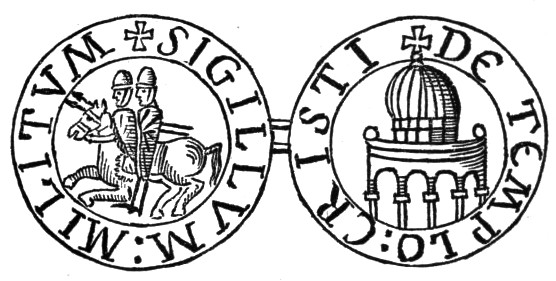
The Count of Champagne met with the highest-ranking nobles, including two that had just returned from the First Crusade, in 1104. The Liege Lord of André de Montbard graced the proceedings with his presence. After the secret meeting, Hughes went back to the Holy Land. He stayed there to around 1108. The Count of Champagne was a very powerful Lord. In 1114, he went back to Champagne and donated the Clairvaux property to St. Bernard. [Seal of the Knights Templar]
Four years later Hughes de Payens, with André de Montbard and seven others, set out on a mission to form the Knights Templar. The year was 1118, the official commencement of the Order of the Temple. Hughes de Payens was the first Grand Master of the Knights.
St. Bernard of Clairveux became the official representative of the Templars, and it was his influence that ensured papal recognition at the Council of Troyes. It was probably just coincidental that Troyes is the capital of Champagne and Hughes' land; just as it was probably accidental that St. Bernard was the nephew of André de Montbard, one of the original members of the Knights. History may indeed rhyme, as the same conductors seem to be writing the score.
Most of the original leading Noble Knights of the First Crusade, as well as those that founded the Knights Templar, were very rich, and from old, well-established families; several of them related directly to Royalty and Royal Houses; others were married to Royalty or both.
However, St. Bernard sounded a call to arms to "sceleratos et impius, raptores et homicidas, adulteros", which roughly translates as "" should save their souls by joining the Knights of the Temple, and they did. The Temple refers to King Solomon's Temple. This sounding led to many questionable individuals signing up to be Knights of the Temple, especially since it took lots of money to outfit a Knight. From whence did all the money come?
FROM WHENCE THE TEMPLARS
The Knights Templar can be traced back to the Prieure de Sion. A small group of monks from Calabria, Italy, founded the Orval Abbey in France in 1070. The Order de Sion was started by this group of monks. Godfroi de Bouillon "folded" them into the Order in 1099 – he was very good at cleaning house.
The lineage of these groups can be traced by to Roman times and beyond, but that will be attempted in later parts. For now we want to concentrate on the Templars and their immediate heritage. We will try to keep it as simple as possible, as the web that has been woven is worthy of Arachne.
Another coincidence – Godfroi de Bouillon, who was one of the main leaders of the First Crusade, whereupon, after conquering Jerusalem, he was made Advocatus Sancti Sepulchri, was also involved in the founding of the Order de Sion.
Further evidence of the Prior of Notre Dame de Sion can be found in Regesta regni Hierosolymitani that was written in 1893. It mentions two charters: one of 1116 by Arnaldus, who was prior of Notre Dame de Sion, and one in 1125, in which Arnaldus's name appears with Hugues Payen, the first Grand Master of the Knights Templar. Marvels just never cease to amaze. Wonder, wonder.
WHO ARE THESE GUYS
Peppin III or Pepin the Short granted a large area in southern France to Theodoric, the first King of the area. Seems that Theodoric felt pretty highly of himself, as he claimed to be descended not only from the Merovingian Kings, but also from King David himself. Both the King and the Pope acknowledged this pedigree. Hmmm.
His son, Guillem de Gellone, was a legendary hero. Seventeen generations later, Godfroi de Bouillon descended, leader of the First Crusade; and, he was confirmed by the Pope to be Advocatus Sancti Sepulchri. The following year his brother Baldwin was made King of Jerusalem.
Godfroi was by lineage, a Merovingian, and he claimed to be the rightful King of Jerusalem by his descent from the House of David, not that we quite buy that one, but we will leave it up to the readers discretion to decide, based on the evidence provided or not provided. Godfroi was buddies with de Payen, and the count of Champagne. Apparently they had a lot in common; and his little brother was the first King of Jerusalem. The Count of Champagne was the Overlord of both St. Bernard of Clairveux and André de Montbard. All in the family – helps with inheritance.
Godfroi de Bouillon also made a list that not many make, as a matter of fact, only nine in all of history have made it – the thrice times three triumvirates known as:
The Nine Worthies:
From pagan times: Hector, son of Priam of Troy; Julius Caesar, and Alexander the Great.
From the Old Testament: Joshua of Canaan; David, King of Israel; and Judas Maccabaeus.
From Christian times: Arthur Pendragon, Charlemagne, and Godfrey de Bouillon.
KING PHILIP & POPE CLEMENT
There is obviously much history that is not possible to presently cover, between the founding of the Templars in 1118, and the year 1307, which marked their ending, at least according to the Church in Rome. The Knights of the Temple fought many a battle for the Holy Roman Catholic Church. Even the Muslim Assassins regarded them as the fiercest fighters in the world, as the Templars never retreated unless outnumbered 3 to 1, and if so ordered by their leader, they would fight until victory or death, whichever came first.
Partly due to their renown for bravery, and the fact that they traveled all over the world, although there are other reasons as well, the Knights became bankers, as it was believed by most that if your money wasn't safe with them, it wouldn't be safe with anyone. Maybe, maybe not – but that was the belief. These early banks, which were all across Europe and the Middle East, from France to Jerusalem, were the first international banking network. The Templars also developed a system of checks, so that a Lord or noble writing a check, based on his money being held in a European bank, could draw money from a bank in the Middle East. Eventually the Order held huge tracks of land and castles, including the entire Island of Cyprus.
The Knights also had a lot of power that no other group had – they only answered to the Pope, and no one else. Kings, Queens, and even Emperors didn't quite make the grade. The Templars were also granted unheard of powers by the Pope through the issuance of Papal Bulls, which were the Pope's form of Royal Prerogatives and Royal Decrees, but the Pope's really carried a wallop, as they could be issued to Kings and Emperors – anyone.
The first Papal Bull was known as Omne Datum Optimum issued in 1139. Besides acknowledging the Knights as a special Order of Fighting Monks who only answered to the Pope, thus receiving Papal protection, the Knights were also officially given the right of all spoils of conquest against the Muslims. They were also exempt from all taxes and tithes.
In 1144 another Papal Bull was issued called Milites Templi and in 1145 Militia Dei was sanctioned. Many extraordinary powers were conferred by these Bulls that no other Order or group held; the one that is of particular interest is the one that gave the Knights Templar the power to collect taxes on Templar property once a year.
Needless to say, these guys were very powerful, not only in regards to fighting, but politically and financially as well. I guess you could say they were God's army on Earth. Being bankers, they not only kept or guarded money, they also lent it out, charging very high rates of interest, usury some called it. King Philip the Fair of France borrowed huge sums from the Knights.
Although Philip was named the Fair, he didn't like to play fair. He owed the Templars a lot pence, and he didn't want to pay it back. What was poor Philip to do? Well, since he was close friends with Bertrand de Got, the Archbishop of Bordeaux, who had always wanted to be Pope, but couldn't quite cut it, Phillip decided to cut it for him, and had Pope Boniface VIII, whom Philip hated, retire to an early grave. Philip then had de Got instituted as Pope Clement V in Avignon, France; where he stayed for his entire reign – the Avignon Captivity of the Papacy.
Some say that Philip made a deal with de Got. Philip would place him as Pope, and in return de Got would excommunicate the Knights Templars by issuing a Papal Bull. Philip figured that unless he could completely eliminate the Knights strength, he would have to repay his loans; and he saw the best way of getting rid of them was to have their only authority – the Pope, denounce them as heretics and excommunicate them.
Once the Knights were excommunicated, they would no longer be under Papal protection and Philip would not have to repay his loans; and to top it all off, Philip and Pope Clement would also be able to confiscate the Knights huge holdings of lands, castles, and other spoils of war – some believe it to be a huge fortune. So Clement issued his infamous Bull, Vox in Excelso.

First the Knights were accused of heresy and other various charges, including homosexuality and devil worship. The charges were enough to get them rounded up and placed under arrest and thrown into the dungeon. Once in prison, the best tool for confession of guilt was put to work – torture, so the Dominican Order of the Holy Roman Catholic Church was called in. Torture was first recorded as being used during the Medieval Inquisition of 1252. See auto de fe.
Here is what the Catholic Encyclopedia says about the incident:
"Philip the Fair made a preliminary inquiry, and, on the strength of so-called revelations of a few unworthy and degraded members, secret orders were sent throughout France to arrest all the Templars on the same day (13 October, 1307), and to submit them to a most rigorous examination. The king did this, it was made to appear, at the request of the ecclesiastical inquisitors, but in reality without their co-operation". Hmm.
Saint Dominic Presiding over an auto de fe,
"In this inquiry torture, the use of which was authorized by the cruel procedure of the age in the case of crimes committed without witnesses, was pitilessly employed. Owing to the lack of evidence, the accused could be convicted only through their own confession and, to extort this confession, the use of torture was considered necessary and legitimate."
"Most of the accused declared themselves guilty of these secret crimes after being subjected to such ferocious torture that many of them succumbed. Some made similar confessions without the use of torture, it is true, but through fear of it; the threat had been sufficient. Such was the case with the grand master himself, Jacques de Molay, who acknowledged later that he had lied to save his life".
So why did the Church send the Dominicans to "interrogate" the prisoners, if they didn't sanction the proceedings? Why did the Pope issue a sounding for the Council of Vienne by the decree of the Papal Bull Regnans in coelis, which was an Ecumenical Council to judicate the support and Papal protection of the Order of the Knights of the Temple?
Why did Pope Clement issue the Papal Bull Vox In Excelso - March 22nd 1312 | The Knights Templar ... that disbanded the Order?
Why did Clement issue the Papal Bull Vox Clamanti, which translates as the sound of one crying, and is a "special plea of solicitude for the general welfare of the Church by Apostolic ordinanceaccording to modum provisionis seu ordinationis apostolicae?"
One can only imagine what the Church would have done if they had cooperated, as opposed to the Catholic Encyclopedia's above claim of non co-operation. Illusion or delusion is left for the reader to decide.
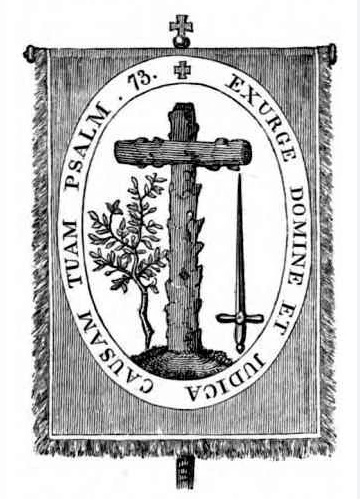
The Banner of the Inquisition
encircled with the quote from Sacred Scripture
"Arise, O God, judge Thy own cause"
[Inquisition]
[Lat. inquirere, to look to]
An interesting participant in the inquisition was Guillaume de Nogaret, keeper of the seal for Philip IV. Nogaret had quite a reputation – for being an advocatus diabolior Devil's Advocate.
What the hell is that? – Well, it's pretty much what it sounds like, a creature from hell that was the Devil's lawyer, or in the Holy Roman Catholic Church hierarchy, "a special lawyer of canon law that would argue cases against canonization for the Church." Tough job, but the pay was good, although the final ante may end up being a bit disconcerting.
One wonders what Christ would have to say about torturing people to get them to admit to what you want them to admit to. A far cry from "those who are without sin cast the first stone". It's ironical how the inquisitions were always inquiring into heresy, which they considered to be any belief structure that differed from theirs. Also begs the question, just who were the heretics at the Council of Nicaei?
This is not to say that the Templars were right or wrong; and were or were not committing the alleged acts, however, the way that King Philip went about disposing of them, so he wouldn't have to repay his loans to them; and the manner in which one Pope was killed and Philips close friend de Got then became Pope, leaves many questions to be answered; not to mention that the Templars had been used by the Church to fight their wars for them, and then when it was all over the Church removes its support and protection and looks the other way as they are tortured, and executed; not to mention they took possession of all their holdings, most of which King Philip ended up with. A Coup d'etat followed by a Coup de Grace – which ranks as one of the most atrocious acts in history, and it is whence the curse of Friday the 13th comes from. It is all very confounding, not to mention a bit scary.
THE END OF THE KNIGHTS
In 1307, King Philip had most of the Knights rounded up and arrested. They had some mock trials, where evidence gathered by admissions of guilt during torture was allowed. Seemed pretty fair for Philip the Fair, and of course what more could be asked of the Church? Most of the Knights died while being tortured or while under captivity in the dudgeons. Those that didn't were executed.
Lastly came the most celebrated Templar Knight – Grandmaster Jacques de Molay (click on link to read the complete story of his execution). Together with Geoffrey de Charney, who was the Preceptor and Commander of Normandy, the two were taken to a small island in the Seine River called Île de la Cité; and were burnt alive.
While dying, Molay was said to challenge Pope Clement V and King Philip to meet him in heaven before God to be judged accordingly, some saying that he thus placed a curse on them both. King Philip and Pope Clement died within the year. Although it is believed that almost all of the Knights had been killed, there was one faction that escaped, and not by accident. On the night of the arrests, the entire Templar fleet mysteriously disappeared from the port of La Rochelle. It is said to have been carrying a vast fortune, the fate of which remains unknown to this day – maybe, maybe not.
THE LEGACY
Time, the grand illusion of all – past, present, future, these three together form the legacy, as they spin and weave the fortune of our fate. As Mick says, "you get what you need."
[Aeschylus, Prometheus Bound 515]
"Whoever you may be, dejected soul,
whose head is downward, planted like a pole,"
my words began, "do speak, if you are able."
I stood as does the friar who confesses
the foul assassin who, fixed fast, head down,
calls back the friar, and so delays his death;
and he cried out: "Are you already standing,
already standing there, o Boniface?"
"You can conclude: the Church in Rome confounds
two powers in itself; into the filth,
it falls and fouls itself and its new burden."
"I see the fleur-de-list enter Anagni and Christ's Vicar made captive
I see the new Pilate so ruthless that this does not sate him,
But without laws he bears into the Temple with his greedy sails.
O my Lord, when shall I rejoice to see the vengeance which,
Hid in thy secret council, makes sweet thy wrath?"
[Dante]
Dante could write with the best of them and the above is beautiful and most telling, however, I must differ that it is not about vengeance – it is about the reckoning. Part IV will be forthcoming.
![]()
© 2005 Douglas V. Gnazzo
![]()
![]()
![]()
Disclaimer:
Some material presented will contain links, quotes, ideologies, etc., the contents of which should be understood to first, in their whole, reflect the views or opinions of their editors, and second, are used in my personal research as "fair use" sources only, and not espousement one way or the other. Researching for 'truth' leads one all over the place...a piece here, a piece there. As a researcher, I hunt, gather and disassemble resources, trying to put all the pieces into a coherent and logical whole. I encourage you to do the same. And please remember, these pages are only my effort to collect all the pieces I can find and see if they properly fit into the 'reality aggregate'.
Personal Position:
I've come to realize that 'truth' boils down to what we 'believe' the facts we've gathered point to. We only 'know' what we've 'experienced' firsthand. Everything else - what we read, what we watch, what we hear - is what someone else's gathered facts point to and 'they' 'believe' is 'truth', so that 'truth' seems to change in direct proportion to newly gathered facts divided by applied plausibility. Though I believe there is 'truth', until someone representing the celestial realm visibly appears and presents the heavenly records of Facts And Lies In The Order They Happened, I can't know for sure exactly what "the whole truth' on any given subject is, and what applies to me applies to everyone. Until then I'll continue to ask, "what does The Urantia Book say on the subject?"
~Gail Bird Allen
![]()
![]()














-
Urantia Book, 44:0.11 - The Celestial Artisans
Never in your long ascendancy will you lose the power to recognize your associates of former existences. Always, as you ascend inward in the scale of life, will you retain the ability to recognize and fraternize with the fellow beings of your previous and lower levels of experience. Each new translation or resurrection will add one more group of spirit beings to your vision range without in the least depriving you of the ability to recognize your friends and fellows of former estates.
-
Princess Bride 1987 Wallace Shawn (Vizzini) and Mandy Patinkin (Inigo Montoya)
Vizzini: HE DIDN'T FALL? INCONCEIVABLE.
Inigo Montoya: You keep using that word. I do not think it means what you think it means. -
Urantia Book, 117:4.14 - The Finite God
And here is mystery: The more closely man approaches God through love, the greater the reality -- actuality -- of that man. The more man withdraws from God, the more nearly he approaches nonreality -- cessation of existence. When man consecrates his will to the doing of the Father's will, when man gives God all that he has, then does God make that man more than he is.
-
Urantia Book, 167:7.4 - The Talk About Angels
"And do you not remember that I said to you once before that, if you had your spiritual eyes anointed, you would then see the heavens opened and behold the angels of God ascending and descending? It is by the ministry of the angels that one world may be kept in touch with other worlds, for have I not repeatedly told you that I have other sheep not of this fold?"
-
Urantia Book, Foreword - 0:12.12 - The Trinities
But we know that there dwells within the human mind a fragment of God, and that there sojourns with the human soul the Spirit of Truth; and we further know that these spirit forces conspire to enable material man to grasp the reality of spiritual values and to comprehend the philosophy of universe meanings. But even more certainly we know that these spirits of the Divine Presence are able to assist man in the spiritual appropriation of all truth contributory to the enhancement of the ever-progressing reality of personal religious experience—God-consciousness.
-
Urantia Book, 1:4.3 - The Mystery Of God
When you are through down here, when your course has been run in temporary form on earth, when your trial trip in the flesh is finished, when the dust that composes the mortal tabernacle "returns to the earth whence it came"; then, it is revealed, the indwelling "Spirit shall return to God who gave it." There sojourns within each moral being of this planet a fragment of God, a part and parcel of divinity. It is not yet yours by right of possession, but it is designedly intended to be one with you if you survive the mortal existence.
-
Urantia Book, 1:4.1 - The Mystery Of God
And the greatest of all the unfathomable mysteries of God is the phenomenon of the divine indwelling of mortal minds. The manner in which the Universal Father sojourns with the creatures of time is the most profound of all universe mysteries; the divine presence in the mind of man is the mystery of mysteries.
-
Urantia Book, 1:4.6 - The Mystery Of God
To every spirit being and to every mortal creature in every sphere and on every world of the universe of universes, the Universal Father reveals all of his gracious and divine self that can be discerned or comprehended by such spirit beings and by such mortal creatures. God is no respecter of persons, either spiritual or material. The divine presence which any child of the universe enjoys at any given moment is limited only by the capacity of such a creature to receive and to discern the spirit actualities of the supermaterial world.
-
Urantia Book, 11:0.1 - The Eternal Isle Of Paradise
Paradise is the eternal center of the universe of universes and the abiding place of the Universal Father, the Eternal Son, the Infinite Spirit, and their divine co-ordinates and associates. This central Isle is the most gigantic organized body of cosmic reality in all the master universe. Paradise is a material sphere as well as a spiritual abode. All of the intelligent creation of the Universal Father is domiciled on material abodes; hence must the absolute controlling center also be material, literal. And again it should be reiterated that spirit things and spiritual beings are real.
-
Urantia Book, 50:6.4 - Planetary Culture
Culture presupposes quality of mind; culture cannot be enhanced unless mind is elevated. Superior intellect will seek a noble culture and find some way to attain such a goal. Inferior minds will spurn the highest culture even when presented to them ready-made.
-
Urantia Book, 54:1.6 - True And False Liberty
True liberty is the associate of genuine self-respect; false liberty is the consort of self-admiration. True liberty is the fruit of self-control; false liberty, the assumption of self-assertion. Self-control leads to altruistic service; self-admiration tends towards the exploitation of others for the selfish aggrandizement of such a mistaken individual as is willing to sacrifice righteous attainment for the sake of possessing unjust power over his fellow beings.
-
Urantia Book, 54:1.9 - True And False Liberty
How dare the self-willed creature encroach upon the rights of his fellows in the name of personal liberty when the Supreme Rulers of the universe stand back in merciful respect for these prerogatives of will and potentials of personality! No being, in the exercise of his supposed personal liberty, has a right to deprive any other being of those privileges of existence conferred by the Creators and duly respected by all their loyal associates, subordinates, and subjects.
-
Urantia Book, 54:1.8 - True And False Liberty
There is no error greater than that species of self-deception which leads intelligent beings to crave the exercise of power over other beings for the purpose of depriving these persons of their natural liberties. The golden rule of human fairness cries out against all such fraud, unfairness, selfishness, and unrighteousness.

